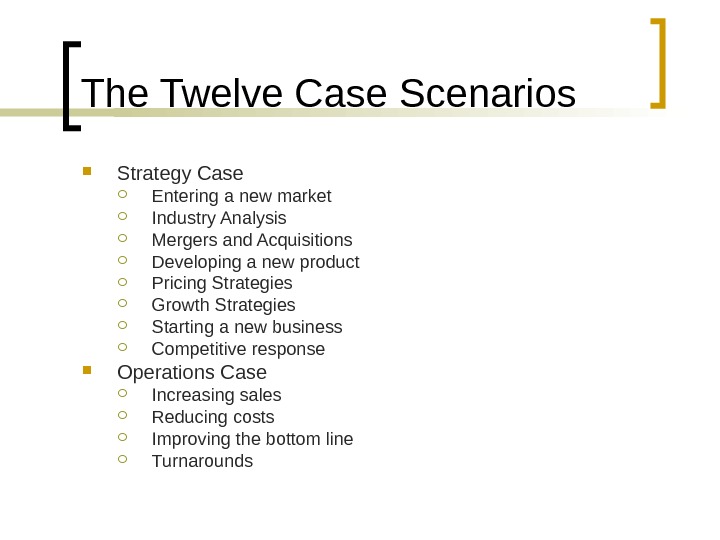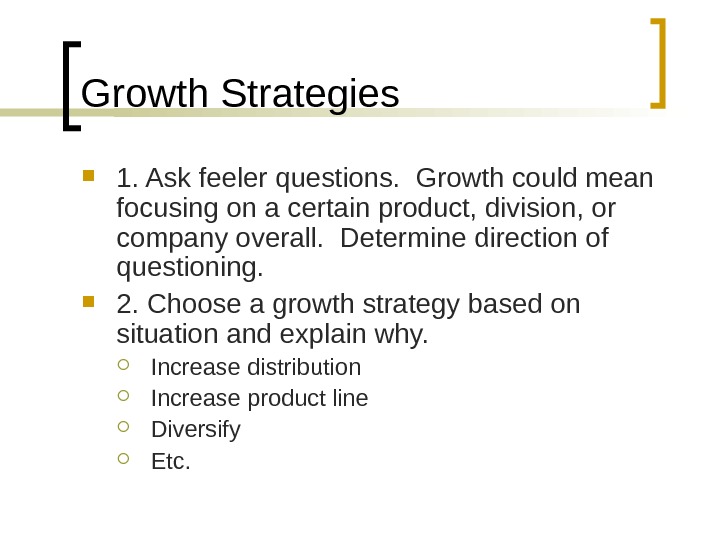Презентация case in point





















- Размер: 58.5 Кб
- Количество слайдов: 20
Описание презентации Презентация case in point по слайдам
 Case in Point A powerpoint summary of types of cases as presented by Marc P. Cosentino (4 th ed. ) By: Helen Lee For the Caltech Consulting Club
Case in Point A powerpoint summary of types of cases as presented by Marc P. Cosentino (4 th ed. ) By: Helen Lee For the Caltech Consulting Club
 The Case Commandments 1. Listen to the Question 2. Take Notes 3. Summarize the question 4. Verify the objective(s) 5. Ask clarifying questions 6. Organize your answer 7. Hold that thought for “one alligator” – think before you speak 8. Manage your time 9. Work the numbers 10. Be coachable 11. Be creative and brainstorm 12. Exude enthusiasm and a positive attitude 13. Bring closure and summarize
The Case Commandments 1. Listen to the Question 2. Take Notes 3. Summarize the question 4. Verify the objective(s) 5. Ask clarifying questions 6. Organize your answer 7. Hold that thought for “one alligator” – think before you speak 8. Manage your time 9. Work the numbers 10. Be coachable 11. Be creative and brainstorm 12. Exude enthusiasm and a positive attitude 13. Bring closure and summarize
 Types of Case Questions Brainteasers Back-of-the-Envelope (estimation questions) Business Case Questions (our focus in this ppt. ) Number cases Business strategy Operations
Types of Case Questions Brainteasers Back-of-the-Envelope (estimation questions) Business Case Questions (our focus in this ppt. ) Number cases Business strategy Operations
 The Ivy Case System 4 initial steps 12 popular case scenarios
The Ivy Case System 4 initial steps 12 popular case scenarios
 The First 4 steps 1. Summarize the question 2. Verify the objective 3. Ask clarifying questions 4. Lay out your structure
The First 4 steps 1. Summarize the question 2. Verify the objective 3. Ask clarifying questions 4. Lay out your structure
 The Twelve Case Scenarios Strategy Case Entering a new market Industry Analysis Mergers and Acquisitions Developing a new product Pricing Strategies Growth Strategies Starting a new business Competitive response Operations Case Increasing sales Reducing costs Improving the bottom line Turnarounds
The Twelve Case Scenarios Strategy Case Entering a new market Industry Analysis Mergers and Acquisitions Developing a new product Pricing Strategies Growth Strategies Starting a new business Competitive response Operations Case Increasing sales Reducing costs Improving the bottom line Turnarounds
 Entering a New Market 1. Determine why? What’s our objective/goal? Does it fit into our overall strategy? 2. Determine the state of the current and future market 3. Investigate the market to determine whether entering it would make good business sense 4. If we decide to enter, we need to figure out the best way to become a player (Cost-benefit analysis) Start from scratch Acquisition Joint venture/strategic alliance
Entering a New Market 1. Determine why? What’s our objective/goal? Does it fit into our overall strategy? 2. Determine the state of the current and future market 3. Investigate the market to determine whether entering it would make good business sense 4. If we decide to enter, we need to figure out the best way to become a player (Cost-benefit analysis) Start from scratch Acquisition Joint venture/strategic alliance
 Industry Analysis 1. Investigate the industry overall Life cycle Performance Client’s position w/in industry Major players and market share Industry changes drivers 2. Suppliers & product availability 3. Future outlook Mergers, acquisitions Barriers to entry
Industry Analysis 1. Investigate the industry overall Life cycle Performance Client’s position w/in industry Major players and market share Industry changes drivers 2. Suppliers & product availability 3. Future outlook Mergers, acquisitions Barriers to entry
 Mergers and Acquisitions 1. determine goals and objectives 2. How much are they paying 3. Due diligence (research the company and the industry) 4. exit strategies
Mergers and Acquisitions 1. determine goals and objectives 2. How much are they paying 3. Due diligence (research the company and the industry) 4. exit strategies
 Developing a New Product 1. Think about the product Special? Patented? Substitutions? 2. Think about market strategy Replacing existing product? Expand sales or customer base? Barriers to entering market Major players 3. Think about customers Who are they and how can we best reach them 4. Think about financing
Developing a New Product 1. Think about the product Special? Patented? Substitutions? 2. Think about market strategy Replacing existing product? Expand sales or customer base? Barriers to entering market Major players 3. Think about customers Who are they and how can we best reach them 4. Think about financing
 Pricing Strategies 1. Investigate the product 2. Choose a pricing strategy Cost-based pricing Price-based costing Competitive analysis 3. Supply and demand
Pricing Strategies 1. Investigate the product 2. Choose a pricing strategy Cost-based pricing Price-based costing Competitive analysis 3. Supply and demand
 Growth Strategies 1. Ask feeler questions. Growth could mean focusing on a certain product, division, or company overall. Determine direction of questioning. 2. Choose a growth strategy based on situation and explain why. Increase distribution Increase product line Diversify Etc.
Growth Strategies 1. Ask feeler questions. Growth could mean focusing on a certain product, division, or company overall. Determine direction of questioning. 2. Choose a growth strategy based on situation and explain why. Increase distribution Increase product line Diversify Etc.
 Starting a new Business 1. Investigate the market 2. Worth investing in? Management Market & Strategic Plan Distribution Channels Products Customers Finance
Starting a new Business 1. Investigate the market 2. Worth investing in? Management Market & Strategic Plan Distribution Channels Products Customers Finance
 Competitive Response 1. analyze competitors’ actions 2. choose one of the following response actions: Acquire the competitor Merge with competitor Copy competitor Hire competitor’s management Increase our own profile with P. R. campaign
Competitive Response 1. analyze competitors’ actions 2. choose one of the following response actions: Acquire the competitor Merge with competitor Copy competitor Hire competitor’s management Increase our own profile with P. R. campaign
 Increasing Sales 1. Increasing sales doesn’t always mean increasing profits. Find underlying reason to increase sales Four ways to increase sales: Increase volume Increase amount of each sale Increase prices Create seasonal balance
Increasing Sales 1. Increasing sales doesn’t always mean increasing profits. Find underlying reason to increase sales Four ways to increase sales: Increase volume Increase amount of each sale Increase prices Create seasonal balance
 Reducing Costs Type A: 1. ask for breakdown of costs 2. investigate any abnormalities 3. benchmark competitors 4. determine any labor-saving technologies that help reduce costs Type B: Internal costs: union wages, suppliers, materials, economics of scale, etc. External costs: economy, interest rates, etc.
Reducing Costs Type A: 1. ask for breakdown of costs 2. investigate any abnormalities 3. benchmark competitors 4. determine any labor-saving technologies that help reduce costs Type B: Internal costs: union wages, suppliers, materials, economics of scale, etc. External costs: economy, interest rates, etc.
 Increasing the bottom line: Profits=(Revenues x Costs)*Volume Identify revenue streams Examine your costs Determine whether you want to pump up the volume
Increasing the bottom line: Profits=(Revenues x Costs)*Volume Identify revenue streams Examine your costs Determine whether you want to pump up the volume
 Turnarounds 1. gather information Why is it failing? Industry analysis Tell me about the company 2. Choose appropriate action Learn as much about the business as possible Review services, products, and finances Secure sufficient funding so your plan has a chance Review talent and temperment of employees, get rid of deadwood Determine goals (short and long term) Business plan Visit clients, suppliers, distributors and reassure them Prioritize goals and get some small success.
Turnarounds 1. gather information Why is it failing? Industry analysis Tell me about the company 2. Choose appropriate action Learn as much about the business as possible Review services, products, and finances Secure sufficient funding so your plan has a chance Review talent and temperment of employees, get rid of deadwood Determine goals (short and long term) Business plan Visit clients, suppliers, distributors and reassure them Prioritize goals and get some small success.
 Caltech Consulting Club Practice cases offered to members of the Caltech community http: //consulting. caltech. edu/ For general announcements, join the mailing list
Caltech Consulting Club Practice cases offered to members of the Caltech community http: //consulting. caltech. edu/ For general announcements, join the mailing list
 The End
The End

